A man and his family are trying to preserve something very important in a remote area of County Mayo – away from the tourist buses and interpretive centers.
The Lost Valley of Uggool is not easy to find. Driving south out of Louisburgh in County Mayo, a small two-lane road narrows to a smaller one lane road bordered by hedges that remind you not to place your arm out the window. After passing ten miles of small and well-kept houses, horse stables and the occasional large lumbering piece of farm machinery, the road ends at the Silver Strand Beach, a sweep of bright sand and rolling dunes that opens to a dark green ocean. This is part of what Fáilte Ireland – the Irish tourist agency – has branded The Wild Atlantic Way. To call the area “remote,” would be an understatement.
Looking west past the islands of Inishturk and Inishbofin, the sun moves horizontally above the sea, soaking the hills that slope to the ocean in a late afternoon light. The green grass and trees glimmer in the wind. When I visited during mid-summer, it didn’t get completely dark until 11 p.m.
No tourist buses arrive at the Lost Valley to unload weary travelers to wander through the area. The land adjacent to the beach and stretching towards Mweelrea Mountain, at 2671 feet, the largest peak in County Mayo, is owned by Gerard Bourke and his family. Bourke traces his ownership of the land to his grandfather Thomas, who worked the land more than a century ago prior to Irish independence. The land back then was part of a large estate owned by an absentee landlord.
Bourke, in his late 50s, left the area when he was 18 years old to work in England and Holland in the construction industry. “I learned a lot about running tractors and other big machinery,” Bourke says about his years away from Ireland. His acquired skills came in handy when he returned to the land that he roamed as a child when he had to walk two miles to a public road.
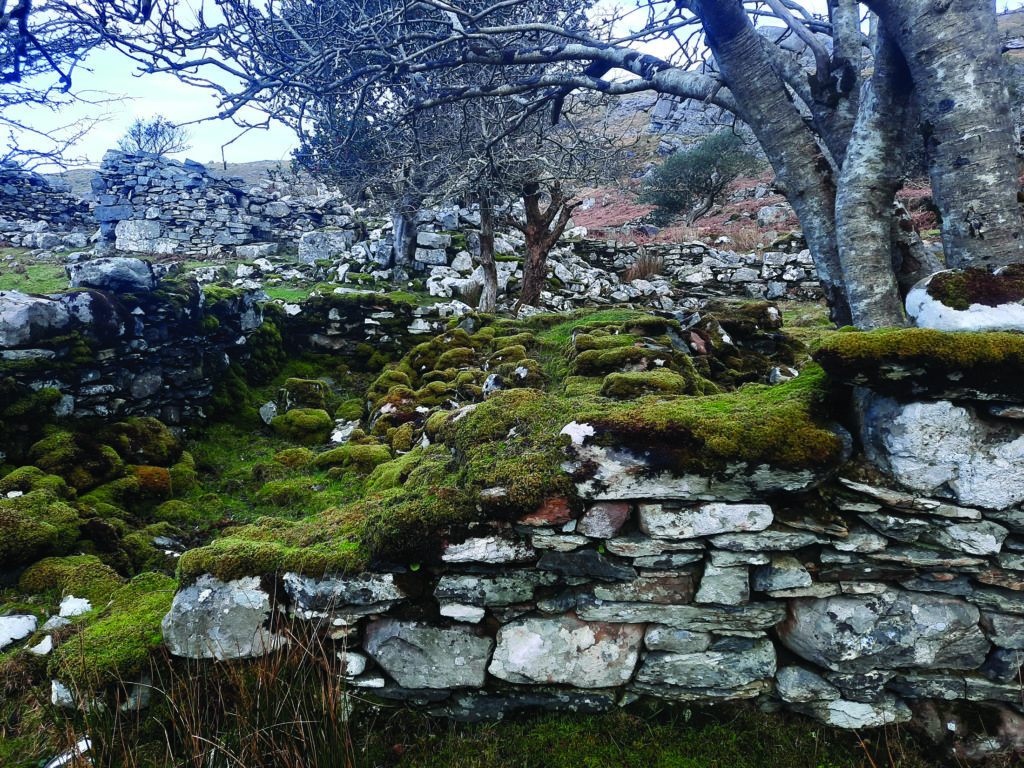
in the parish of Louisburg, dispossessing over 1,300 people.
He immediately started planning to transform the area that was already a working sheep farm, into a place to explore the history and legacy of the Irish Famine. “I grew up playing in the old abandoned village as a child and the history of that village and the people who lived and died there is written on the landscape,” he said as he walked with his sheep dog at the head of a group of twenty-five visitors there for the morning tour.
A mile or so from the house overlooking the Silver Strand where Bourke and his family now live, sit the stone remains of several homes that date back to the beginning of the 19th century. Stones that once held up the walls of a family home are covered with dense clumps of green moss. Twenty yards away, small dirt mounds about fifteen feet long rise a foot or so out of the ground. The story of the Irish Famine is, of course, partly the story of the potato, the staple of at least half of the Irish population in the mid-1840s. Famine historian Cormac O’Grada estimates that Irish smallholders and cottiers – rural laborers – ate up to fourteen pounds of potatoes daily. Bourke stills grows them on a small plot next to the tour path.
Bourke stands atop one of the stone walls that is now one stop on his three-hour 2.8 mile walking tour of the famine village. He opens the area for tourists from mid-May until late September. He talks passionately about his family’s presence in the area and the tragic legacy of one of the worst famines in human history. Over a million people died of starvation and disease – over 10 percent of the population at the time – and millions more left Ireland never to return. “Imagine the trauma that these people – adults and children – experienced right here. They starved and were driven off the land towards death or an exile that also meant death in many cases,” he says.
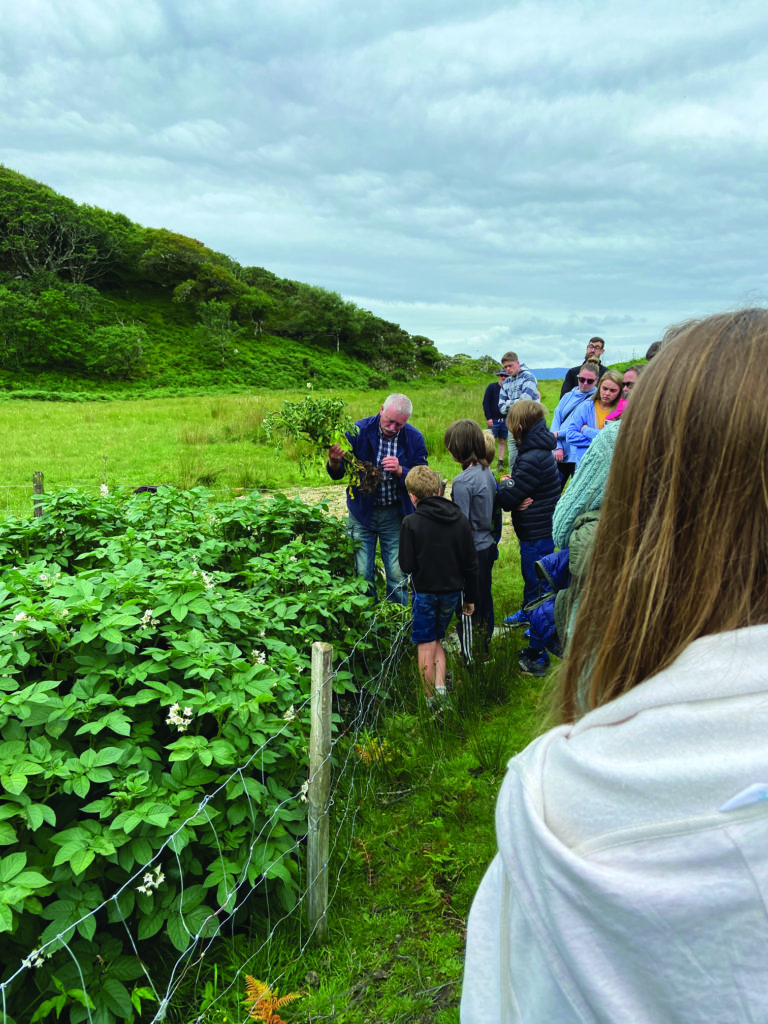
There is no “interpretive center” here where tourists can browse through interactive displays or computers that offer historical background for what visitors are looking at. There is only the self-educated Bourke and his own point of view and passions about making sure the painful history of the area is not forgotten. His family spent their own money and energy fixing the roads, preserving the cottages and placing informational plaques and markers along the route. “The people who lived here deserve to have the truth told as accurately as possible,” Bourke said.
One plaque half way through the walk is affixed to a rock which in a brief few paragraphs recounts an eyewitness testimony to the horrors of the famine. According to W.J. Bennet, who traveled through the area in 1847, he saw families huddled together with emaciated children “all but naked,” crouched over the last embers of a turf fire. Many were too weak to lift a limb or speak.
County Mayo was one of the most devastated areas during the famine. In the ten-year period between 1841 and 1851, Mayo’s population decreased by 29 percent. The Louisburgh parish, of which the Lost Valley was a part, lost half of its population between 1841 and 1851 according to census reports. Those who died – nearly 100,000 in Mayo according to O’Grada – were either landless or near landless. Lacking economic resources, emigration was not an option.
One of the lessons that Bourke outlines on the tour is that part of the reason that the British response was late, inadequate and resulted in so much unnecessary death is that political and social leaders believed the slothful Irish brought the devastation upon themselves. “It is my belief that the propaganda about Irish stupidity and ignorance perpetrated by the Whig government of the time was for the purpose of ethnic cleansing and probable genocide,” he said.
This is not the way most academic historians talk or write. They are generally more attuned to nuance, stressing the political and economic context of the time and how dominant ideologies limited bold action. Oxford historian R. F. Foster, who has written a general history of Ireland, a biography of William Butler Yeats and a short work on Seamus Heaney, worries that “emotive” popular histories of Ireland might ratchet up “the volume of blame” for noxious political purposes.
Moreover, in his essay “Theme-parks and Histories,” he points to a tendency – not limited to Ireland – to turn history into therapy and commodified, simplified and packaged entertainment for American tourists. We study history not for personal or collective “catharsis,” Foster writes, but to understand the “fractured, divergent realities, and the complications and nuances behind the various stories.”
Bourke, who says he spent the three winters before opening the tour reading everything he could find about the famine, says the only college he attended was the “college of life.” As he rolls out his story on the walk, he makes his historical points by quoting the words and ideas of the political and social elites of the 1840s. Standing amidst brown and slate-colored rocks clustered at his feet that were once wedged into a cottage wall, Bourke quotes the self-justifying excuses for inaction of Assistant Secretary of the Treasury Charles Trevelyan. “Trevelyan,” Bourke firmly says, pointing out that he was responsible for famine relief at the time, “wrote that the famine was a blessing…applied by the direct stroke of an all-wise Providence in a manner as unexpected and unthought of as it is likely to be effectual.”
Bourke also quotes Lord Palmerston’s 1848 letter to Lord John Russell: “It is useless to disguise the truth ….this change [in agricultural production] necessarily implies a long, continued and systematic ejectment of small holders and squatting cottiers.” Palmerston, then British Foreign Secretary and later Prime Minister, was an absentee landlord with a large estate in County Sligo.
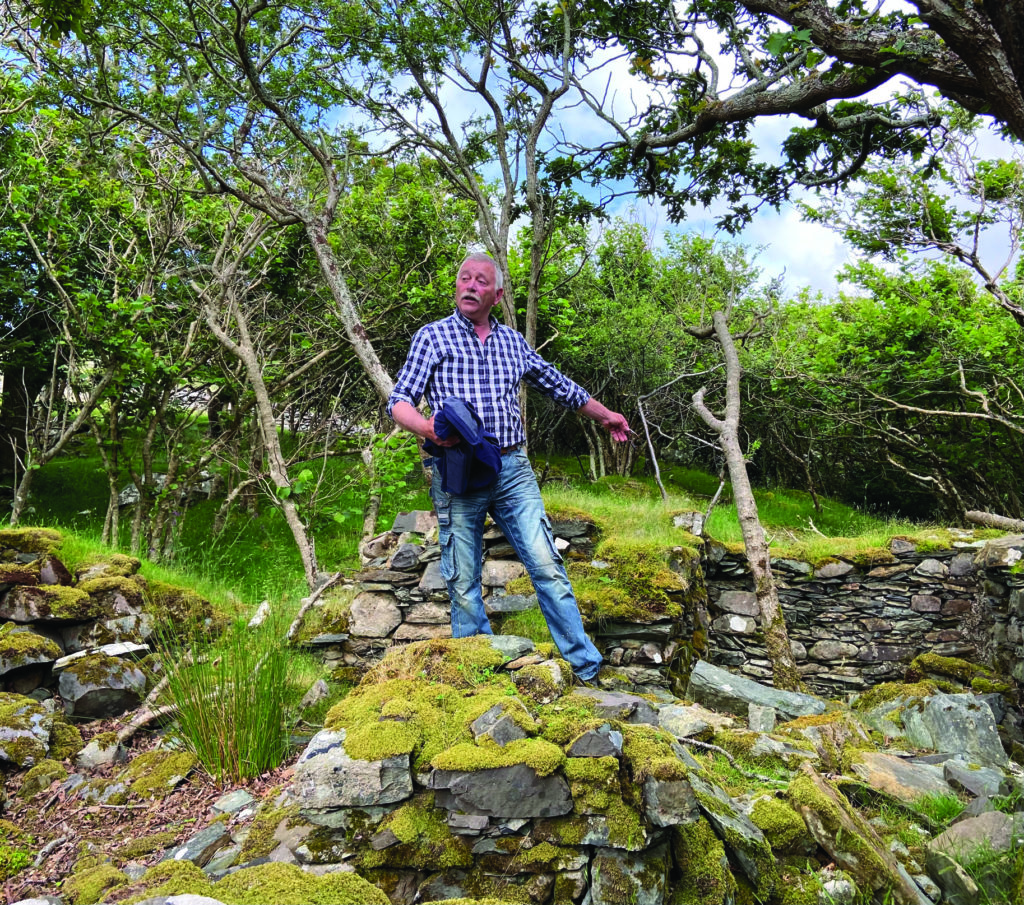
The Times declared in 1847 that the Irish are ‘a people born and bred from time immemorial, in inveterate indolence, improvidence, disorder and consequent destitution….’
While few historians believe that deliberate genocide was at work through British policy, the cruelty of their response to the famine was inseparable from the political domination of Ireland, ideological folly and deep prejudice.
Amartya Sen, the Nobel Prize winning Indian economist has written about famines throughout the world and argues that famines, given the right political circumstances, are extremely easy to prevent. What is required to forestall a famine, Sen writes in his essay, “Nobody Need Starve,” is democracy, political independence and a government that is willing to act to provide the economic means for the destitute to acquire food.
Sen also points to the ruling elite’s impulse to offer some character defect of the victims as the primary cause of their own misfortune. Prime Minister Winston Churchill responded to the Bengal Famine of 1943, when the British Raj was still controlling India, with the observation that the Indian people had the tendency to “breed like rabbits.” The Irish, both in Britain and the United States, were often described in newspapers and commentary as apelike and depraved. Dehumanization of the dominated has always been a signature trope of imperialism and social oppression.
“The rulers never starve,” Sen points out, but robust democracy and a free press in an independent state – absent from Ireland in the 1840s – can pass on the price of inaction and incompetence to the political elite through elections and public pressure. Looking down into the valley, Bourke suggests that “If the politicians had been starving, their ideology would have changed very quickly.”
One of the virtues of walking with strangers – in this case from different parts of Ireland, the United States and France – is that information and ideas can be shared within the group as you proceed. A young woman from Dublin sought out the tour as part of her interest in learning more about Irish history. “We learn about the famine in school of course,” she commented. “But coming here I can imagine more clearly the stark reality these people faced.” According to Bourke, his family obtained the land as a result of land reform initiated by the London government to undermine the strength of the Irish National Land League, founded in County Mayo in 1878. Charles Stewart Parnell, John Dillon and Michael Davitt, (whose parents were evicted from Mayo in 1850), were key leaders, demanding a reduction in land rents paid by tenant farmers, an end to evictions and the ability of tenants to purchase the lands they worked. According to historian Christine Kinealy, the Land League transformed the land question “into a mass movement.”
A Congested Districts Board of Ireland was established in 1891 that, according to Ciara Breathnach, Associate Professor of History at University of Limerick, was aimed at “pacifying Irish agrarian unrest by a combination of coercive and conciliatory measures.” The “congestion” was not of people, even though Mayo had 475 people per square mile while the Irish average was 134, but of poverty. Burke’s grandfather Thomas, who had lived and worked on the land, was granted a loan to purchase the acreage by the Congested Districts Board. Ownership passed to Bourke’s father Michael and then to him. During the famine times, the land was owned by a local landlord, Lord Sligo who lived in Westport, 25 miles from the Lost Valley who is quoted as saying, “I have to evict or I will be evicted,” Bourke Lord Sligo and Lord Lucan, who lived in Castlebar, were the two largest landholders in Mayo and were responsible for thousands of evictions that led to a predictable death.
As we followed Bourke up the dirt road that looped around the valley, he pointed to the Hawthorne and Thornbush trees that lined the path. “The Hawthorn Tree was regarded by the Celts as a sacred tree where fairies met and danced beneath,” he said. He added that there was a strong belief in the olden days – perhaps still prevalent – that if you interfered with a lone Hawthorn tree, misfortune would befall yourself or your family.
As he spoke I was reminded of Seamus Heaney’s poem “Keeping Going,” where he writes about his brother Hugh:
“When the thorn tree was cut down You broke your arm. I shared the dread When a strange bird perched for days on the byre roof."
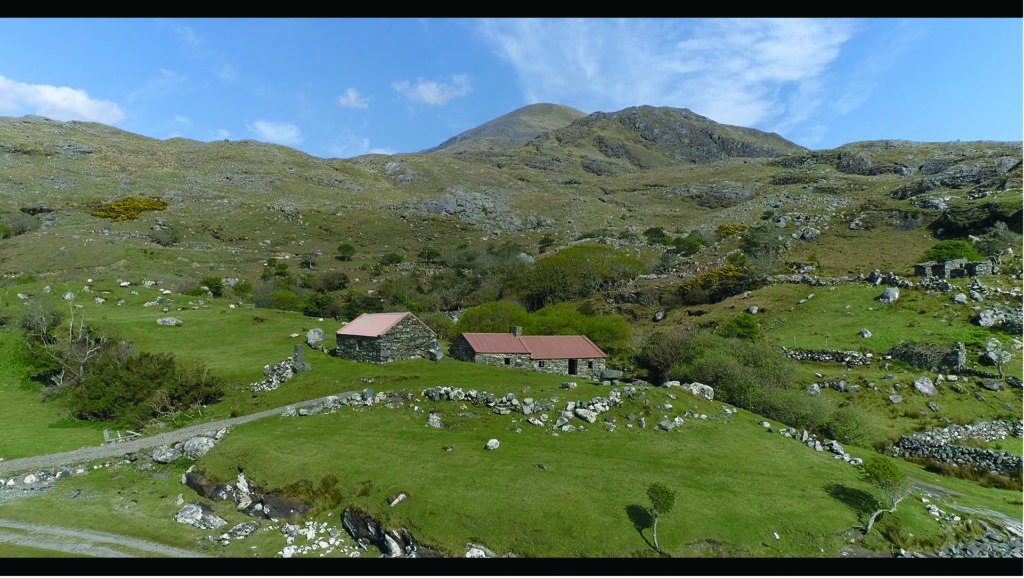
At the highest point of the journey there is a stunning view of the Killary Fjord looking South towards the village of Rosroe and Leenane further on. The Austrian philosopher Ludwig Wittgenstein lived in Rosroe for long periods between 1947 and 1949, drawn to the stark landscape and the isolation that allowed contemplation and writing.
The end of the tour is a walk down a steep grassy slope past a couple of dozen grazing sheep towards a completely intact stone cottage in the small valley below. Wispy strings of smoke drift out of the chimney, the sweet smell of a turf fire discernable in the breeze. Bourke’s great, great, great grandfather lived in the cottage in the early 1800s. “We put a good roof on it,” Bourke says. “A stone cottage like this can be preserved for a long time if you can keep water from running into the walls.” Everyone was offered tea and biscuits before the short walk back to our cars.
Driving back along the road towards Louisburgh I felt conflicting emotions. Our group agreed that visiting the Lost Valley was a moving and educational experience. And yet, there was a part of me that felt I was also a tourist of someone else’s trauma, a stoic observer of the ruins of history. Perhaps it was an unavoidable feeling. If the Irish Famine drove many towards angry denunciation of the government and political action, others were “traumatized into muteness,” pushing against the limits of what is describable.
Far from a “theme park,” Bourke and his family have preserved a pristine area of remote landscape and created an intellectual and emotional jumping off point for interrogating the past. The area has been designated a National Heritage site which limits development and the number of sheep and cattle that can be grazed there. “I’m fine with all of the restrictions,” Burke says. “This area should be preserved in the state that it is in. When you enter here, you are walking into a profound part of Irish history. ♦

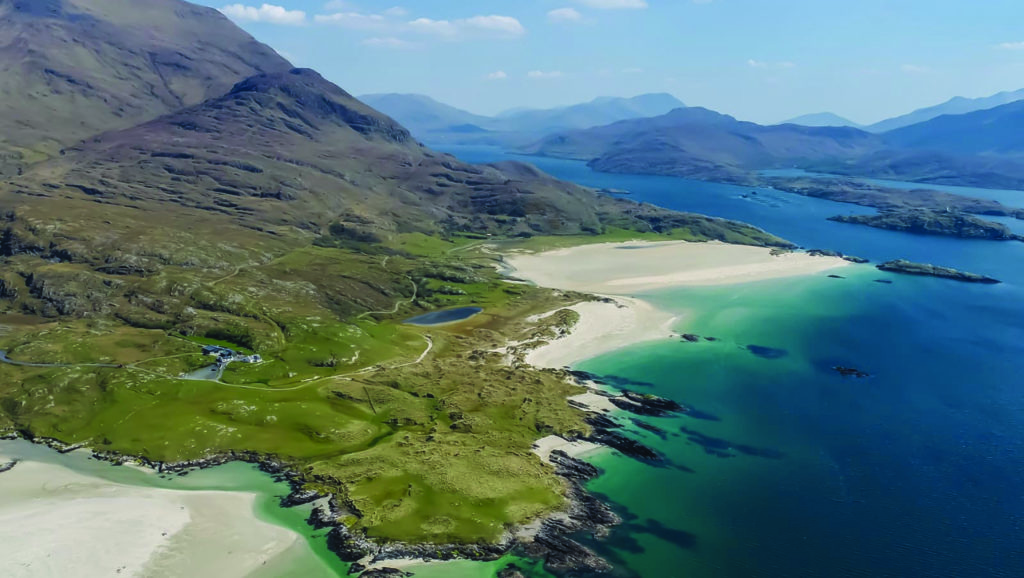
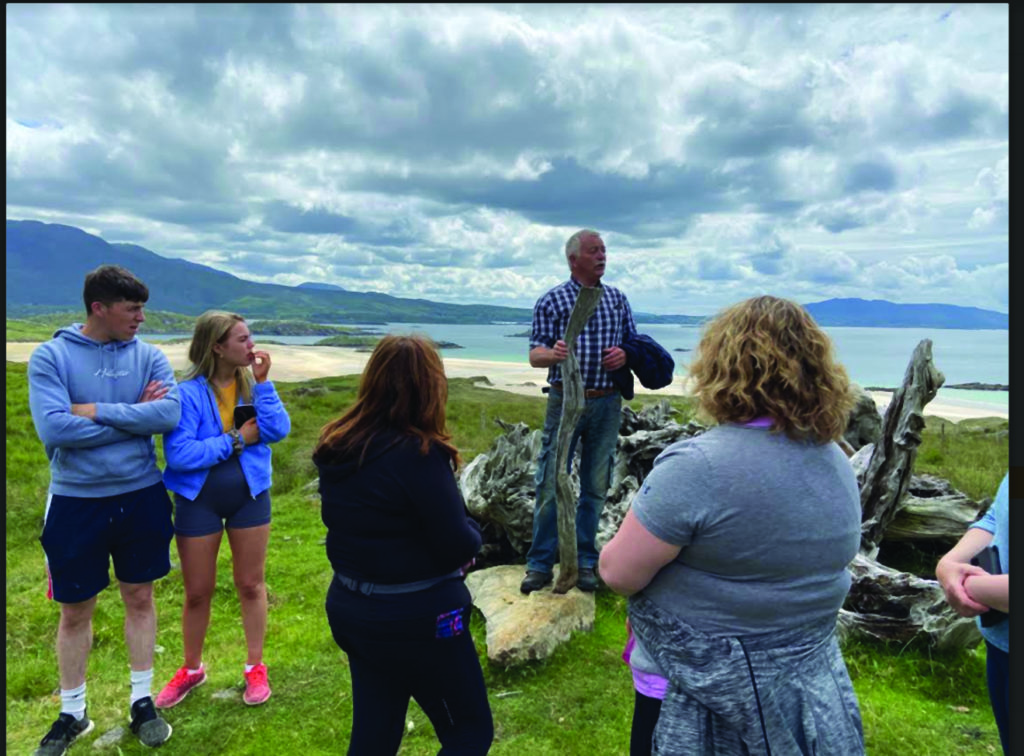
Such a good read so much needed information how the people suffered . So many people are not aware of the suffering of the Irish people. Thank you
While some historians might not label The Great Hunger as genocide, how else would one describe the exportation of food from Ireland during those years, coupled with evictions, the razing of homes by landlords, and the banning of the Irish language, Catholicism, and other Irish customs?